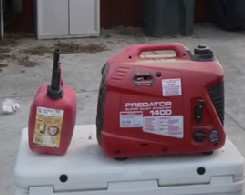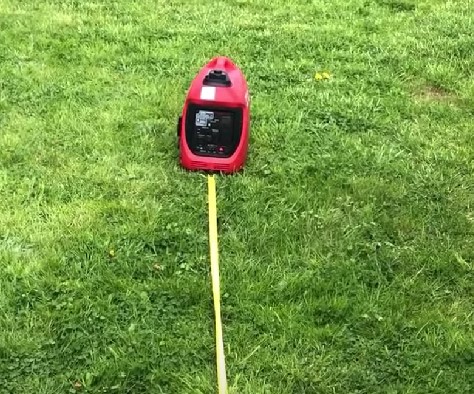A 1400-watt generator is a versatile and compact power solution, perfect for camping trips, tailgating, and emergency backup during power outages. Understanding the capabilities and limitations of your generator is essential to ensure its safe and efficient operation.
In this blog post, we will explore the appliances a 1400-watt generator can run and offer tips for maximizing efficiency and safety.
Understanding Wattage and Generator Capacity
Wattage is a measure of electrical power, and it is crucial to know how it relates to generator capacity. A generator’s capacity is the maximum amount of power it can produce, measured in watts. It is important to distinguish between running watts, the continuous power required by a device, and starting watts, the temporary surge of power needed to start a device.
To avoid overloading your generator, you should determine the combined wattage of the devices you plan to run simultaneously.
Common Appliances That1400-Watt Generator Can Run
A. Electronic Devices
- Laptops: Most laptops consume between 50 and 150 watts, making them ideal candidates for a 1400-watt generator.
- Smartphones: Charging smartphones requires minimal power, usually less than 10 watts, so you can easily charge multiple phones at once.
- LED TVs: Modern LED TVs consume around 30-100 watts, depending on the size, making them suitable for a 1400-watt generator.
B. Small Kitchen Appliances
- Coffee maker: A standard drip coffee maker typically uses 600-1200 watts, so you can brew your morning cup with your generator.
- Microwave oven: Small microwave ovens with a power output of 700 watts can be run by a 1400-watt generator.
- Toaster: Most toasters use 800-1500 watts, so a small two-slice toaster should work with a 1400-watt generator.

C. Lighting Solutions
- LED light bulbs: LED bulbs consume very little power, usually between 9-20 watts, allowing you to light up several rooms.
- Compact fluorescent lamps (CFL): CFLs are more energy-efficient than incandescent bulbs, typically using 13-23 watts, making them a suitable option for your generator.
D. Fans and Space Heaters
- Box fans: Box fans consume between 50 and 100 watts, allowing you to run multiple fans on your 1400-watt generator.
- Portable space heaters: Small space heaters rated at 700-1200 watts can be used with a 1400-watt generator, but avoid running other high-wattage appliances simultaneously.
E. Power Tools
- Cordless drills: Cordless drills usually require 70-100 watts for charging, making them compatible with a 1400-watt generator.
- Orbital sanders: Most orbital sanders consume between 200 and 400 watts, allowing you to power them with your generator.
- Electric chainsaws: Small electric chainsaws can run on a 1400-watt generator, as they typically require 900-1200 watts.
Appliances a 1400-Watt Generator Cannot Run
It is essential to avoid overloading your generator to ensure safety and prevent damage to both the generator and your appliances. A 1400-watt generator has limitations, and there are several common appliances that require more power than it can provide.
Some of these include:
- Air Conditioners: Most window air conditioning units consume between 1500 and 2000 watts, making them too demanding for a 1400-watt generator.
- Electric Stoves: Electric stoves typically require between 2000 and 5000 watts, far exceeding the capacity of a 1400-watt generator.
- Large Refrigerators: Full-sized refrigerators can use anywhere from 1500 to 2000 watts, including the initial surge power needed to start the compressor, which is beyond the capacity of a 1400-watt generator.
- Clothes Dryers: Electric clothes dryers usually consume around 3000 to 5000 watts, making them incompatible with a 1400-watt generator.
- Water Heaters: Electric water heaters typically require between 3000 and 4500 watts, which is too much for a 1400-watt generator to handle.
- Heavy-Duty Power Tools: Some power tools, such as table saws, air compressors, and large electric chainsaws, have wattage requirements that exceed 1400 watts, making them unsuitable for use with a 1400-watt generator.
When planning to use a 1400-watt generator, carefully assess the power needs of your appliances and be mindful of the generator’s limitations. Overloading the generator can lead to its malfunction, damage your appliances, or even create hazardous conditions.
Tips for Maximizing Efficiency and Safety
When using a 1400-watt generator, it’s essential to maximize efficiency and maintain safety. Here are some tips to help you get the most out of your generator while ensuring safe operation:
Staggering Appliance Use
Instead of running multiple high-wattage appliances simultaneously, stagger their use to avoid overloading your generator. Turn off one appliance before starting another to manage power demand effectively.
Energy Conservation
Be mindful of conserving energy to reduce the load on your generator. Unplug devices when not in use, switch off lights in unoccupied rooms, and opt for energy-efficient appliances and lighting solutions.
Extension Cords and Proper Wiring
Use heavy-duty, outdoor-rated extension cords that are the appropriate length and gauge for the appliances you’re running. Avoid using damaged cords, and do not connect multiple cords together. Proper wiring is crucial for the safety and the efficient operation of your generator.
Regular Maintenance
Maintain your generator according to the manufacturer’s recommendations to ensure optimal performance and safety. Check and change the oil regularly, inspect air filters, and test the spark plug for proper operation. Always store fuel safely and ensure the generator is adequately ventilated during use.
Load Balancing
Distribute the load evenly between the generator’s outlets to prevent imbalances and reduce the risk of overloading. Consult your generator’s manual for guidance on proper load balancing.
Monitor Generator Performance
Regularly check the generator’s performance by monitoring output voltage and frequency. If you notice any fluctuations or deviations from the recommended values, address the issue immediately to prevent damage to your appliances or the generator itself.
Prepare for Emergencies
Have a backup plan in place for situations where your generator might fail or be insufficient to meet your power needs. Keep essential supplies, such as flashlights and batteries, on hand and have a plan for alternative power sources if necessary.
By following these tips, you can maximize the efficiency of your 1400-watt generator and ensure its safe operation, providing you with reliable power when you need it most.

Frequently Asked Question
How many amps does a 1400-watt generator put out?
To calculate the amperage output of a 1400-watt generator, you need to use the formula:
Amps = Watts / Volts
In the United States and many other countries, the standard voltage for residential use is 120 volts. Using this voltage, you can calculate the amperage output of a 1400-watt generator as follows:
Amps = 1400 watts / 120 volts Amps ≈ 11.67
So, a 1400-watt generator typically puts out approximately 11.67 amps at 120 volts. Keep in mind that the actual amperage output may vary slightly depending on the specific generator model and its efficiency. Always refer to the manufacturer’s specifications for the most accurate information.
Will a 1400-watt generator run a refrigerator?
A 1400-watt generator might be able to run a small or energy-efficient refrigerator, but it may struggle with larger models or those with additional features, such as ice makers or water dispensers.
Refrigerators typically consume between 100 and 800 watts during normal operation. However, they require a significantly higher power surge (starting watts) when the compressor starts up. This power surge can range from 800 to 1200 watts or more, depending on the refrigerator’s size and type.
To determine whether a 1400-watt generator can run a specific refrigerator, you need to consider both the running watts and the starting watts of the refrigerator. If the combined wattage falls within the generator’s capacity, it should be able to run the refrigerator.
It’s important to note that if you plan to run other appliances simultaneously with the refrigerator, you should account for their wattage as well. Overloading a generator can lead to its malfunction, damage your appliances, or create hazardous conditions.
If you’re unsure whether your 1400-watt generator can handle your refrigerator and other appliances, consult the manufacturer’s specifications and consider seeking advice from a professional electrician.
Will 1400 watt generator run an air conditioner?
A 1400-watt generator is generally not sufficient to run most air conditioning units. Air conditioners typically have high power requirements, and their wattage needs depend on factors such as cooling capacity (measured in BTUs) and efficiency.
Window air conditioning units usually consume between 500 and 1500 watts or more, depending on their size and cooling capacity. Portable air conditioners may have similar wattage requirements. Additionally, air conditioners require a higher power surge (starting watts) when the compressor starts up, which can be considerably more than their running watts.
Given these power requirements, most air conditioners will likely exceed the capacity of a 1400-watt generator. Overloading a generator can cause it to malfunction, damage your appliances, or create hazardous conditions.
If you need to power an air conditioner with a generator, consider investing in a larger generator with a higher wattage capacity. Always consult the manufacturer’s specifications for your air conditioner and generator to ensure compatibility and safe operation.
Conclusion
In conclusion, a 1400-watt generator is a versatile and practical power solution for a variety of situations, from camping trips to emergency backups during power outages. While it can efficiently run a range of common appliances, including electronic devices, small kitchen appliances, lighting solutions, fans, and power tools, it’s essential to be aware of its limitations and avoid overloading the generator.
